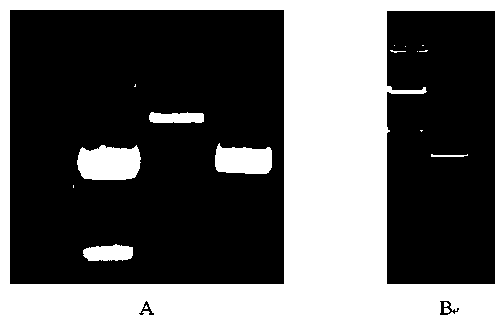Calcineurin catalytic subunit gene and application thereof
A technology of calcineurin catalytic subunit and phosphatineurin catalytic subunit, which is applied in the application field of active aluminum, can solve the problems of self-inhibitory domain shedding and reduce the self-inhibition effect of self-inhibitory domain on enzyme activity, and achieve Low technical cost, increased aluminum resistance, and easy operation
- Summary
- Abstract
- Description
- Claims
- Application Information
AI Technical Summary
Problems solved by technology
Method used
Image
Examples
Embodiment 1
[0024] Embodiment 1: Cryptococcus terrestris ( C . humicolus ) Cloning and identification of CNA gene of BSLL1-1 strain
[0025] Genomic DNA of Cryptococcus terrestris was extracted (Osper et al., Molecular Biology Experiment Guide (Fifth Edition), Beijing: Science Press, 2008), and sent to Shanghai Human Genome Research Center for genome sequencing to obtain the CNA genome sequence , design primers according to the sequence, the primer sequence is as follows: Forward primer CNA-F: 5'-GGATCCATGACCCTCTCCGGCGACCCAGC-3' (underlined as Bam HI restriction site), reverse primer CNA-R: 5'-AAGCTTTTAGGCAATAGAGTTCTCGG-3' (underlined Han dIII restriction site). Using the cDNA of Cryptococcus terrestris as a template, the designed primers were used to amplify the CNA gene fragment. The PCR reaction conditions were: pre-denaturation at 94°C for 3 min, followed by 30 cycles of denaturation at 94°C for 30 s, annealing at 65°C for 30 s, and extension at 72°C for 2 min. After the cycle,...
Embodiment 2
[0026] Example 2: Verification of the interaction between CNA and CaM
[0027] Synthesize CNA polypeptide 611-627: RLAEVISSPTKGGQGER, immunize male rabbits, and prepare CNA antibody;
[0028] 1) Immunization: Select about 3.0kg New Zealand white rabbits. Before immunization, take negative serum from the ear vein, take 1000μg of the polypeptide of the catalytic subunit of calcineurin, dilute it to 1000μl with normal saline, and then add an equal volume of Freund's adjuvant ( Freund's complete adjuvant was used for the initial immunization, and Freund's incomplete adjuvant was used for the booster immunization). Grind and mix the solution and adjuvant with a mortar to make the solution into a water-in-oil state. The well-mixed immunogen is injected subcutaneously, and generally immunized three times, the first two immunizations are separated by two weeks, and the last immunization is separated by one week. For the first immunization, 2-3 points are injected on the soles of the...
Embodiment 3
[0033] Example 3: Heterologous Expression of CNA Proteins
[0034] Using the cDNA of Cryptococcus terrestris as a template, the CNA fragment was amplified with specific primers CNA-F and CNA-R, and then combined with restriction endonuclease Bam HI / Han The dIII-digested pET-32a vector was ligated and transformed into Escherichia coli BL21(DE3) strain to obtain the recombinant plasmid pET-32a-CNA. extract the plasmid Bam HI / Han dIII double enzyme digestion identification, two bands of the same size as the target band and the vector fragment were detected, such as figure 2 , indicating that the prokaryotic expression vector pET-32a-CNA was successfully constructed. The recombinant plasmid pET-32a-CNA was transformed into Escherichia coli BL21(DE3) to obtain the recombinant strain Escherichia coli BL21(DE3)-pET-32a-CNA containing the recombinant expression plasmid.
[0035] Recombinant Escherichia coli BL21 (DE3)-pET-32a-CNA bacterial strain and control bacterial stra...
PUM
 Login to View More
Login to View More Abstract
Description
Claims
Application Information
 Login to View More
Login to View More - R&D
- Intellectual Property
- Life Sciences
- Materials
- Tech Scout
- Unparalleled Data Quality
- Higher Quality Content
- 60% Fewer Hallucinations
Browse by: Latest US Patents, China's latest patents, Technical Efficacy Thesaurus, Application Domain, Technology Topic, Popular Technical Reports.
© 2025 PatSnap. All rights reserved.Legal|Privacy policy|Modern Slavery Act Transparency Statement|Sitemap|About US| Contact US: help@patsnap.com



